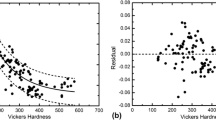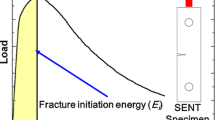Abstract
Edge failure during stretching of sheared edges limits the use of sheet steels in a number of product applications. The shearing process causes a highly strained region adjacent to the shear face, called the shear-affected zone. In the present study, the strain-hardening rate at uniform elongation, Z, is used as an empirical measure of cohesive strength at the interface of the various phases in steel microstructures. The higher the value of Z, the lower the macro strain when voids begin to form that lead to decohesion of the interface and subsequent failure. The data from four different studies are used to show that the true circumferential strain at failure in a hole expansion is a direct function of Z for most microstructural conditions. Sheet steels that exhibit better performance than that which would be expected for their Z values have one or more of the following characteristics—an increase in ferrite strength, lower carbon martensite in DP steels, or TRIP steels. A hot-rolled ferrite/pearlite microstructure is the only case of decreased true circumferential strain at failure for a given value of Z.





Similar content being viewed by others
References
B.S. Levy and C.J. Van Tyne, Review of the Shearing Process for Sheet Steels and Its Effect on Sheared Edge Stretching, J. Mater. Eng. Perform., 2011, doi:10.1007/s11665-011-9997-x
S.B. Lee, J.G. Speer, Matlock, and K.G. Chin, Analysis of Stretch-Flangability Using a Ductile Fracture Model, Proceedings of 3rd International Conference on Advanced Structural Steels, H.C. Lee, Ed. (Seoul, Korea), Korean Institute of Metals and Materials, 2006, p 841–849
Z. Milosevec and F. Moussy, Simulation of sheared edge behavior in stretch flanging by a modified Fukui test, Advanced Technology of Plasticity, Vol II, K. Lange, Ed., Springer-Verlag, Berlin, Germany, 1987, p 697–702
X. Sun, K.S. Choi, W.N. Lui, and M.A. Khaleel, Predicting Failure Modes and Ductility of Dual Phase Steels Using Plastic Strain Localization, Int. J. Plast., 2009, 25, p 1888–1909
J.H. Kim, M.G. Lee, D. Kim, D.K. Matlock, and R.H. Wagoner, Hole-Expansion Formability of Dual Phase Steels Using Representative Volume Element Approach with Boundary-Smoothing Technique, Mater. Sci. Eng. A, 2010, 527, p 7353–7363
S.B. Lee, J.G. Speer, and D.K. Matlock, The Influence of Phase Distribution and Interfaces on Fracture and Formability of High Strength Steel Sheets, Proceedings of International Conference on Advanced High Strength Sheet Steels for Automotive Applications (Warrendale, PA, USA), AIST, 2004, p 383–394
S.B. Lee, D.K. Matlock, and J.G. Speer, Ductile Fracture Criteria Based on Damage Accumulation Rate, Proceedings of 19th Conference on Mechanical Behavior of Materials (Seoul, Korea), Korean Institute of Metals and Materials, 2005, p 183–197
A.W. Hudgins, D.K. Matlock, J.G. Speer, and C.J. Van Tyne, Predicting Instability at Die Radii in Advanced High Strength Steels, J. Mater. Process. Technol., 2010, 210, p 741–750
D.K. Matlock and J.G. Speer, Design Considerations for the Next Generation of Advanced High Strength Steel Sheets, Proceedings of 3rd International Conference on Advanced Structural Steels, H.C. Lee, Ed. (Seoul, Korea), Korean Institute of Metals and Materials, 2006, p 774–781
R.D.K. Misra, S.W. Thompson, T.A. Hylton, and A.J. Boucek, Microstructures of Hot-Rolled High-Strength Steels with Significant Differences in Edge Formability, Metall. Mater. Trans. A, 2001, 32A, p 745–759
M. Sudo, S. Hashimoto, and S. Kambe, Niobium Bearing Ferrite-Bainite High Strength Hot Rolled Steel with Improved Formability, Trans. Iron Steel Inst. Jpn., 1983, 23, p 303–311
N. Fujita, T. Nonaka, T. Tomoko, H. Taniguchi, K. Goto, and K. Yamazaki, Development of Ultra-High Strength Steel Sheets with Tensile Strength of 980 MPa, SAE Paper No. 2007-01-0341, Steel Innovations, Fatigue Research, Sheet/Hydro/Gas Forming Technology & Advanced High Strength Steel Development, SP 2103, SAE International, Warrendale, PA, USA, 2007, p 51–55
M. Sudo and I. Kokubo, Microstructure-Mechanical Property Relations in Multi-Phase Steel, Scand. J. Met., 1984, 13, p 329–342
T. Takashashi, O. Kawano, Y. Tanaka, and M. Ohara, Fracture Mechanical Study on Edge Flangability of High Tensile Strength Sheet Steels, Steel Processing, Product, and Applications Symposium at MS&T (Warrendale, PA, USA), TMS, 2009
S.B. Lee, “Microstructural Influences on the Fracture Behavior of Multi-Phase Sheet Steels,” Ph.D. dissertation, Colorado School of Mines, Golden, CO, USA, 2005
R.G. Davies, Influence of Silicon and Phosphorus on the Mechanical Properties of Both Ferrite and Dual Phase Steels, Metall. Trans. A, 1979, 10A, p 113–118
X. Fang, Z. Fan, B. Ralph, P. Evans, and R. Underhill, The Relationships Between Tensile Properties and Hole Expansion Property of C-Mn Steels, J. Mater. Sci., 2003, 38, p 3877–3882
S. Sriram, C. Wong, M. Huang, B. Yan, and D. Urban, Formability Characterization of a New Generation of High Strength Steels, Report No. 0012, American Iron and Steel Technology Roadmap Program Office, Pittsburgh, PA, USA, 2003
B.S. Levy and C.J. Van Tyne, Failure During Sheared Edge Stretching, J. Mater. Eng. Perform., 2008, 17, p 842–848
A. Konieczny and T. Henderson, On Formability Limitations in Stamping Involving Sheared Edge Stretching, SAE Paper No. 2007-01-0340, Steel Innovations, Fatigue Research, Sheet/Hydro/Gas Forming Technology & Advanced High Strength Steel Development, SP 2103, SAE International, Warrendale, PA, USA, 2007, p 41–50
Author information
Authors and Affiliations
Corresponding author
Rights and permissions
About this article
Cite this article
Levy, B.S., Van Tyne, C.J. Effect of a Strain-Hardening Rate at Uniform Elongation on Sheared Edge Stretching. J. of Materi Eng and Perform 21, 2147–2154 (2012). https://doi.org/10.1007/s11665-011-0116-9
Received:
Published:
Issue Date:
DOI: https://doi.org/10.1007/s11665-011-0116-9




